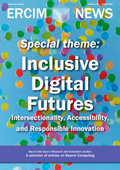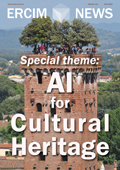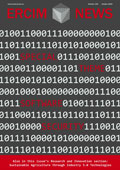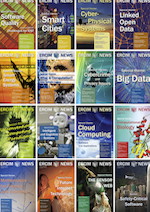by Damien Dechambre and Isabelle Lacoffrette (Inria)
Digital tools have become essential to our personal and professional lives. With the rise of remote work, most administrative and business processes have moved online. It has become nearly impossible to manage without a smartphone or internet access! When digital accessibility is overlooked, millions of people with disabilities are excluded, along with those who are digitally marginalized (such as older adults or individuals with limited digital skills). Implementing and respecting digital accessibility within an organization, institution, or company means promoting inclusion for all!
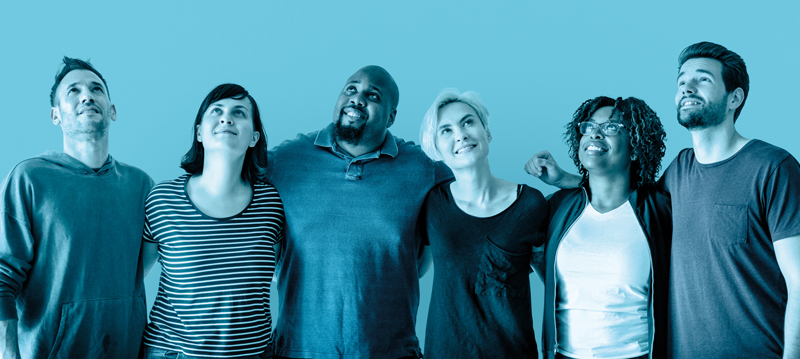
Inclusivity makes us strong.
Digital accessibility means creating and developing digital tools and content in a way that allows people with disabilities to use them without barriers. More than just a definition, it is a social issue. In Europe, 27% [L1] of people have a disability. It is also a legal obligation, which is too often forgotten, neglected, not enforced, not verified, defined in particular by Directive (EU) 2016/2102 [L2] and more recently by the European Accessibility Act [L3] of 2019 concerning goods and services (banks, insurance, e-commerce, etc.).
Hearing, motor, visual, cognitive impairments... Disabilities take many forms and can arise at any stage of life, whether due to an accident, a disabling illness, or the natural effects of aging. It is important to note that 80% of disabilities are “invisible” and 85% appear during a lifetime. This means that we can all be affected at some point in our lives, either directly or indirectly, by a temporary or permanent disability. Digital accessibility helps ensure that people can continue to engage in society, access employment, and remain in the workforce.
It is therefore essential to implement digital accessibility across an organization’s information systems, for both internal and external users. This demands a comprehensive approach that ensures the creation and distribution of content accessible to everyone. Accessible digital content and services allow employees with disabilities to perform their work, collaborate with colleagues, and progress in their careers on an equal footing. Conversely, they may find themselves excluded, leading to psychosocial risks. An organization that has implemented a digital accessibility approach can retain its employees and also recruit new ones.
Any organization or company that provides digital content or services to the public must ensure they are accessible to everyone. Not being able to complete administrative procedures online can have serious consequences for individuals and their resources, whether in terms of health or various forms of assistance. Accessibility is also becoming a marker of responsibility. In a context where the commitment of organizations and companies is scrutinized by the public, being accessible is becoming an asset in terms of image, corporate social responsibility (CSR), and attractiveness. Young people, in particular, are attentive to these issues and prefer inclusive companies.
Implementing digital accessibility in an organization is not inherently complex, but it requires time and is achieved gradually over the long term. There are international standards that have established norms (W3C, WCAG, WAI [L4, L5, L6]) with their regional variations, such as at the European Union level with the EN 301 549 standard [L7] (transcribed as RGAA in France and RAAM in Luxembourg). This means that IT services, such as software and web service providers, have access to these reference materials to design accessible digital tools and services and audit them.
For example, at Inria (the French digital science research institute), the process of implementing digital accessibility began in March 2022. After assembling and training a multidisciplinary team, the work began with a focus on the following points: steering accessibility (compliance with regulations, prioritization of actions, monitoring of indicators), raising awareness among staff through webinars, training, and events so that everyone is familiar with the subject and complies with it in their daily work (e.g., creating accessible content), providing support and advice, and facilitating a network/staying informed about changes in legislation and technology. In addition to raising awareness among its own staff, Inria has launched a website open to all, featuring simulations of situations involving disabilities [L8].
In addition to the regulatory aspect, the digital accessibility team works closely with the human resources department's disability unit to listen to the issues and needs of staff with disabilities. This collaboration has made it possible to build up a pool of testers with disabilities to help with continuous improvement. We can therefore also be inclusive in our approach!
Inria is also committed to these research teams through the priorities defined in its Disability Plan 2025-2028, focusing on R&D aspects. There are at least 16 research teams working on three main themes:
- designing and evaluating original and innovative interactive digital technologies and environments for the inclusion and empowerment of people with disabilities and loss of autonomy
- developing multimodal approaches and tools to analyze the movements and behaviors of people with disabilities
- NeuroFB-BCI-Functional stimulation to explore the nerve circuits involved, particularly in motor control, and how to rehabilitate them in the event of impairments.
The institute has set up annual “Inria disability and digital science” days where research teams meet to exchange and share their knowledge in this field. Another significant initiative is the handitechlabInria [L9] which develops solutions for and with people with disabilities.
Since March 2022, Inria has improved the digital accessibility of its information system and raised awareness among all business lines. This work, combined with that of the human resources department's disability unit, has increased the employment rate of people with disabilities from 2.82% in 2022 to 4.15% in 2024 (an increase of almost 50% in two years). There is still much work to be done.
This is a mission that demands foresight and sustained commitment, but the reward is significant: inclusion for all!
Links:
[L1] https://www.consilium.europa.eu/fr/infographics/disability-eu-facts-figures/
[L2] https://eur-lex.europa.eu/legal-content/FR/TXT/HTML/?uri=CELEX:32016L2102
[L3] https://ec.europa.eu/social/main.jsp?catId=1202&intPageId=5581&langId=en
[L4] https://w3.org
[L5] https://www.w3.org/WAI/standards-guidelines/wcag
[L6] https://www.w3.org/WAI/
[L7] https://accessible-eu-centre.ec.europa.eu/content-corner/digital-library/en-3015492021-accessibility-requirements-ict-products-and-services_en
[L8] https://simulation-accessibilite.inria.fr/public/en/index.html
[L9] https://project.inria.fr/handitechlabinria/
Reference:
[1] P.A. Cinquin, P. Guitton, and H. Sauzéon, "Toward truly accessible MOOCs for persons with cognitive impairments: a field study", Human–Computer Interaction, 38(5-6), 352-373, 2023.
Please contact:
Damien Dechambre
Inria, France
Isabelle Lacoffrette
Inria, France

